Amani Abusafia
Immersive 3D Simulator for Drone-as-a-Service
Oct 29, 2023



Abstract:We propose a 3D simulator tailored for the Drone-as-a-Service framework. The simulator enables employing dynamic algorithms for addressing realistic delivery scenarios. We present the simulator's architectural design and its use of an energy consumption model for drone deliveries. We introduce two primary operational modes within the simulator: the edit mode and the runtime mode. Beyond its simulation capabilities, our simulator serves as a valuable data collection resource, facilitating the creation of datasets through simulated scenarios. Our simulator empowers researchers by providing an intuitive platform to visualize and interact with delivery environments. Moreover, it enables rigorous algorithm testing in a safe simulation setting, thus obviating the need for real-world drone deployments. Demo: https://youtu.be/HOLfo1JiFJ0
CrowdWeb: A Visualization Tool for Mobility Patterns in Smart Cities
May 22, 2023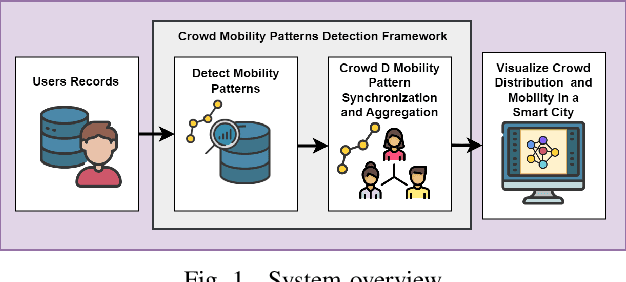
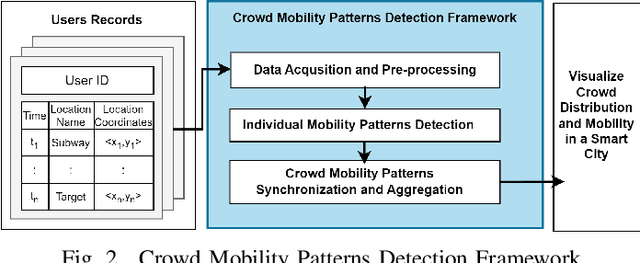
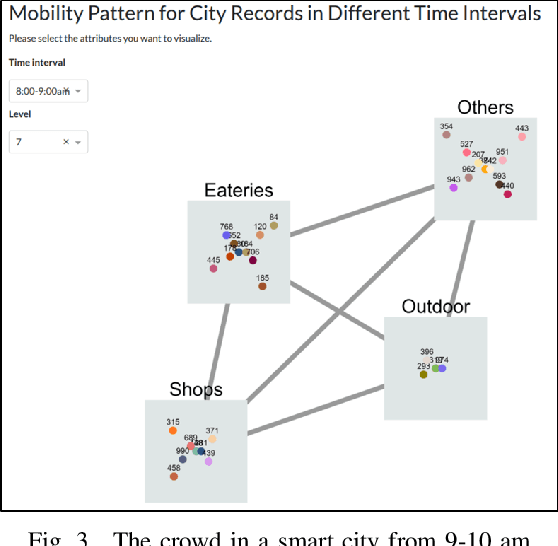
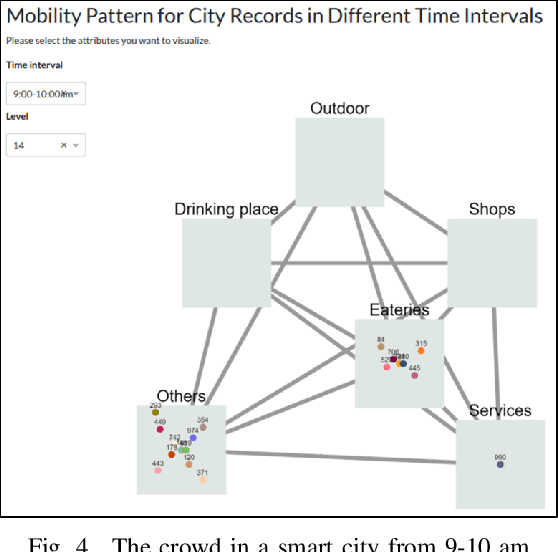
Abstract:Human mobility patterns refer to the regularities and trends in the way people move, travel, or navigate through different geographical locations over time. Detecting human mobility patterns is essential for a variety of applications, including smart cities, transportation management, and disaster response. The accuracy of current mobility prediction models is less than 25%. The low accuracy is mainly due to the fluid nature of human movement. Typically, humans do not adhere to rigid patterns in their daily activities, making it difficult to identify hidden regularities in their data. To address this issue, we proposed a web platform to visualize human mobility patterns by abstracting the locations into a set of places to detect more realistic patterns. However, the platform was initially designed to detect individual mobility patterns, making it unsuitable for representing the crowd in a smart city scale. Therefore, we extend the platform to visualize the mobility of multiple users from a city-scale perspective. Our platform allows users to visualize a graph of visited places based on their historical records using a modified PrefixSpan approach. Additionally, the platform synchronizes, aggregates, and displays crowd mobility patterns across various time intervals within a smart city. We showcase our platform using a real dataset.
Energy Loss Prediction in IoT Energy Services
May 16, 2023Abstract:We propose a novel Energy Loss Prediction(ELP) framework that estimates the energy loss in sharing crowdsourced energy services. Crowdsourcing wireless energy services is a novel and convenient solution to enable the ubiquitous charging of nearby IoT devices. Therefore, capturing the wireless energy sharing loss is essential for the successful deployment of efficient energy service composition techniques. We propose Easeformer, a novel attention-based algorithm to predict the battery levels of IoT devices in a crowdsourced energy sharing environment. The predicted battery levels are used to estimate the energy loss. A set of experiments were conducted to demonstrate the feasibility and effectiveness of the proposed framework. We conducted extensive experiments on real wireless energy datasets to demonstrate that our framework significantly outperforms existing methods.
Monitoring Efficiency of IoT Wireless Charging
Mar 10, 2023Abstract:Crowdsourcing wireless energy is a novel and convenient solution to charge nearby IoT devices. Several applications have been proposed to enable peer-to-peer wireless energy charging. However, none of them considered the energy efficiency of the wireless transfer of energy. In this paper, we propose an energy estimation framework that predicts the actual received energy. Our framework uses two machine learning algorithms, namely XGBoost and Neural Network, to estimate the received energy. The result shows that the Neural Network model is better than XGBoost at predicting the received energy. We train and evaluate our models by collecting a real wireless energy dataset.
In-Flight Energy-Driven Composition of Drone Swarm Services
Oct 28, 2022Abstract:We propose a novel framework for swarm-based drone delivery services with in-flight energy recharging. The framework aims to enhance the delivery time of multiple packages by reducing the number of stops and recharging times at intermediate stations. The proposed framework considers various intrinsic and extrinsic delivery constraints. We propose to use support drones whose sole purpose is to recharge other drones in the swarm during their flight. In this respect, we compute the optimal set of optimal support drones to minimize the probability of delivery services and recharging time at the next stations. We also use two settings to position the support drones in a flight formation for comparative purposes. Two novel energy sharing methods are proposed, namely, Priority-based and Fairness-based methods. A re-ordering method of the delivery drones is presented to facilitate the in-flight energy composition process. An enhanced A* algorithm is implemented to compose the optimal services in terms of delivery time. Experimental results prove the efficiency of our proposed approach.
IMAP: Individual huMAn mobility Patterns visualizing platform
Sep 08, 2022
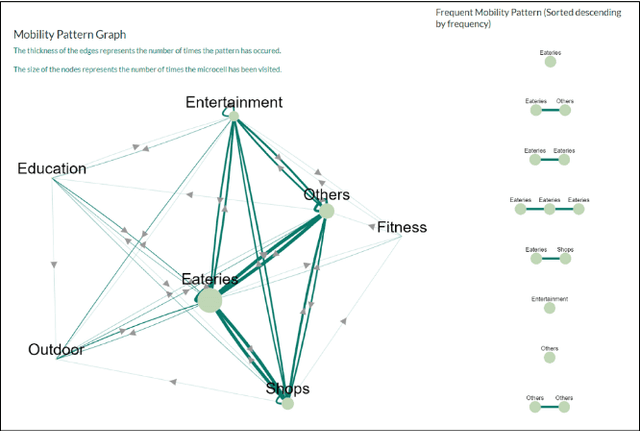
Abstract:Understanding human mobility is essential for the development of smart cities and social behavior research. Human mobility models may be used in numerous applications, including pandemic control, urban planning, and traffic management. The existing models' accuracy in predicting users' mobility patterns is less than 25%. The low accuracy may be justified by the flexible nature of the human movement. Indeed, humans are not rigid in their daily movement. In addition, the rigid mobility models may result in missing the hidden regularities in users' records. Thus, we propose a novel perspective to study and analyze human mobility patterns and capture their flexibility. Typically, the mobility patterns are represented by a sequence of locations. We propose to define the mobility patterns by abstracting these locations into a set of places. Labeling these locations will allow us to detect close-to-reality hidden patterns. We present IMAP, an Individual huMAn mobility Patterns visualizing platform. Our platform enables users to visualize a graph of the places they visited based on their history records. In addition, our platform displays the most frequent mobility patterns computed using a modified PrefixSpan approach.
DIY-IPS: Towards an Off-the-Shelf Accurate Indoor Positioning System
Sep 08, 2022

Abstract:We present DIY-IPS - Do It Yourself - Indoor Positioning System, an open-source real-time indoor positioning mobile application. DIY-IPS detects users' indoor position by employing dual-band RSSI fingerprinting of available WiFi access points. The app can be used, without additional infrastructural costs, to detect users' indoor positions in real time. We published our app as an open source to save other researchers time recreating it. The app enables researchers/users to (1) collect indoor positioning datasets with a ground truth label, (2) customize the app for higher accuracy or other research purposes (3) test the accuracy of modified methods by live testing with ground truth. We ran preliminary experiments to demonstrate the effectiveness of the app.
Occupancy Estimation from Thermal Images
Oct 15, 2021


Abstract:We propose a non-intrusive, and privacy-preserving occupancy estimation system for smart environments. The proposed scheme uses thermal images to detect the number of people in a given area. The occupancy estimation model is designed using the concepts of intensity-based and motion-based human segmentation. The notion of difference catcher, connected component labeling, noise filter, and memory propagation are utilized to estimate the occupancy number. We use a real dataset to demonstrate the effectiveness of the proposed system.
 Add to Chrome
Add to Chrome Add to Firefox
Add to Firefox Add to Edge
Add to Edge